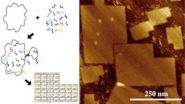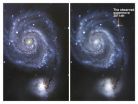(Press-News.org) Researchers from North Carolina State University, Duke University and the University of Copenhagen have created the world's largest DNA origami, which are nanoscale constructions with applications ranging from biomedical research to nanoelectronics.
"These origami can be customized for use in everything from studying cell behavior to creating templates for the nanofabrication of electronic components," says Dr. Thom LaBean, an associate professor of materials science and engineering at NC State and senior author of a paper describing the work.
DNA origami are self-assembling biochemical structures that are made up of two types of DNA. To make DNA origami, researchers begin with a biologically derived strand of DNA called the scaffold strand. The researchers then design customized synthetic strands of DNA, called staple strands. Each staple strand is made up of a specific sequence of bases (adenine, cytosine, thaline and guanine – the building blocks of DNA), which is designed to pair with specific subsequences on the scaffold strand.
The staple strands are introduced into a solution containing the scaffold strand, and the solution is then heated and cooled. During this process, each staple strand attaches to specific sections of the scaffold strand, pulling those sections together and folding the scaffold strand into a specific shape.
The standard for DNA origami has long been limited to a scaffold strand that is made up of 7,249 bases, creating structures that measure roughly 70 nanometers (nm) by 90 nm, though the shapes may vary.
However, the research team led by LaBean has now created DNA origami consisting of 51,466 bases, measuring approximately 200 nm by 300 nm.
"We had to do two things to make this viable," says Dr. Alexandria Marchi, lead author of the paper and a postdoctoral researcher at Duke. "First we had to develop a custom scaffold strand that contained 51 kilobases. We did that with the help of molecular biologist Stanley Brown at the University of Copenhagen.
"Second, in order to make this economically feasible, we had to find a cost-effective way of synthesizing staple strands – because we went from needing 220 staple strands to needing more than 1,600," Marchi says.
The researchers did this by using what is essentially a converted inkjet printer to synthesize DNA directly onto a plastic chip.
"The technique we used not only creates large DNA origami, but has a fairly uniform output," LaBean says. "More than 90 percent of the origami are self-assembling properly."
INFORMATION:
The paper, "Toward Larger DNA Origami," is published online in Nano Letters. The paper was co-authored by Dr. Ishtiaq Saaem, a former Ph.D. student at Duke; Dr. Briana Vogen, a former postdoctoral researcher at NC State; and Dr. Stanley Brown at the University of Copenhagen.
The research was supported by the National Science Foundation under grants CDI-0835794, OISE-1246799, and EPMD-1231888, and by the University of Copenhagen.
Researchers create world's largest DNA origami
2014-09-11
ELSE PRESS RELEASES FROM THIS DATE:
New superfoods could help key protein keep bodies healthy
2014-09-11
A new generation of new superfoods that tackle heart disease and diabetes could be developed following research into a protein that helps keep cells in our bodies healthy.
Researchers at the University of Warwick found that the protein, called Nrf2, continually moves in and out of the nuclei of human cells to sense the cell's health and vitality.
When Nrf2 is exposed to threats to the cell's health it oscillates faster and activates an increase in the cell's defence mechanism, including raising the levels of antioxidant.
The researchers, from the University's Warwick ...
Childhood mentors have positive impact on career success
2014-09-11
New research from North Carolina State University finds that young people who have had mentors are more likely to find work early in their careers that gives them more responsibility and autonomy – ultimately putting them on a path to more financially and personally rewarding careers.
"We wanted to look at the long-term impacts on mentees in naturally occurring mentorship relationships, rather than participants in formal mentorship programs," says Dr. Steve McDonald, an associate professor of sociology at NC State and lead author of a paper on the work. "And we found ...
Graphene paints a corrosion-free future
2014-09-11
The surface of graphene, a one atom thick sheet of carbon, can be randomly decorated with oxygen to create graphene oxide; a form of graphene that could have a significant impact on the chemical, pharmaceutical and electronic industries. Applied as paint, it could provide an ultra-strong, non-corrosive coating for a wide range of industrial applications.
Graphene oxide solutions can be used to paint various surfaces ranging from glass to metals to even conventional bricks. After a simple chemical treatment, the resulting coatings behave like graphite in terms of chemical ...
Lurking bright blue star caught!
2014-09-11
This release is available in Japanese.
A team led by Gastón Folatelli at the Kavli IPMU, the University of Tokyo, has found evidence of a hot binary companion star to a yellow supergiant star, which had become a bright supernova. The existence of the companion star had been predicted by the same team on the basis of numerical calculations. This finding provides the last link in a chain of observations that have so far supported the team's theoretical picture for this supernova. The results are published in the Astrophysical Journal Letters and have wide implications for ...
High levels of physical activity linked to better academic performance in boys
2014-09-11
A recent Finnish study shows that higher levels of physical activity are related to better academic achievement during the first three school years particularly in boys. The study published in PLOS ONE was conducted in collaboration with the Physical Activity and Nutrition in Children (PANIC) Study conducted at the University of Eastern Finland and the First Steps Study at the University of Jyväskylä.
The study investigated the relationships of different types of physical activity and sedentary behavior assessed in the first grade to reading and arithmetic skills in grades ...
Smokers who consume too much sodium at greater risk of developing rheumatoid arthritis
2014-09-11
A new study published online in the journal Rheumatology today indicates that the interaction between high sodium intake and smoking is associated with a more than doubled risk of developing rheumatoid arthritis (RA).
The study, carried out by Björn Sundström and colleagues from the Department of Public Health and Clinical Medicine, Rheumatology at Umeå University, Sweden, was carried out to see whether recent animal and human cell study results that showed a link between a high sodium intake and RA would yield similar results in a nested case-control study of data from ...
'Fat shaming' doesn't encourage weight loss
2014-09-11
Discrimination against overweight and obese people does not help them to lose weight, finds new UCL research funded by Cancer Research UK.
In a study of 2,944 UK adults over four years, those who reported experiencing weight discrimination gained more weight than those who did not. On average, after accounting for baseline differences, people who reported weight discrimination gained 0.95kg whereas those who did not lost 0.71kg, a difference of 1.66kg.
The research, published in the journal Obesity, contradicts the common perception that discrimination or 'fat shaming' ...
More needed to protect our sportspeople from brain injury, say Birmingham experts
2014-09-11
Two University of Birmingham academics are calling for more research to be carried out looking at how the brains of sportspeople – including children – react when they receive a blow to the head.
Their call is echoed by Dawn Astle and Peter Robinson. Dawn Astle, is the daughter of former West Bromwich Albion player Jeff Astle who, an inquest found, died from brain trauma caused by heading heavy footballs - a condition known as Chronic Traumatic Encephalopathy (CTE). Peter Robinson is the father of Ben Robinson, whose son died as a result of repeated concussions during ...
The Lancet Diabetes & Endocrinology: 1 in 4 people with diabetes worldwide live in China, but a new approach could help transform their care
2014-09-11
Diabetes has become a major public health crisis in China, with an annual projected cost of 360 billion RMB (nearly 35 billion British pounds) by 2030, but a new collaborative approach to care that uses registries and community support could help improve diabetes care, according to a new three-part Series about diabetes in China published in The Lancet Diabetes & Endocrinology.
China has the largest number of people with diabetes of any country in the world, and the disease has reached epidemic proportions in the adult population [Paper 1]. In 1980, less than 1% of Chinese ...
Study: Role of emergency contact is mistaken for advance directive
2014-09-11
DETROIT – More than 95 percent of patients treated in an Emergency Department mistake their emergency contact as the designated medical decision maker for end-of-life care, according to a new study by Henry Ford Hospital in Detroit.
The study is being presented Wednesday at the 20th International Congress on Palliative Care in Montreal.
Erin Zimny, M.D., a Henry Ford Emergency Medicine and Palliative Care physician and a study co-author, attributes the misunderstanding to health care practitioners routinely asking patients for their emergency contact information without ...




